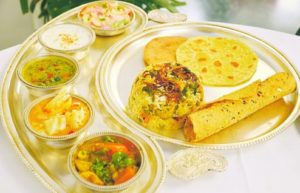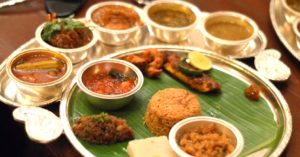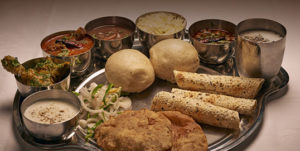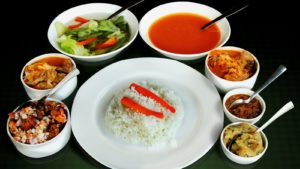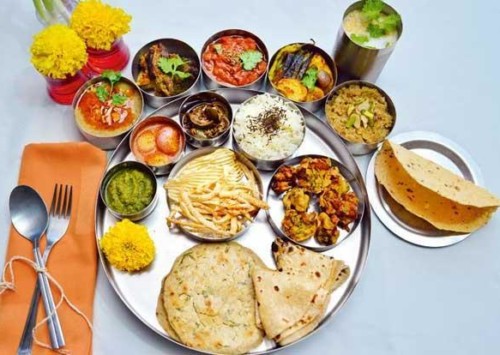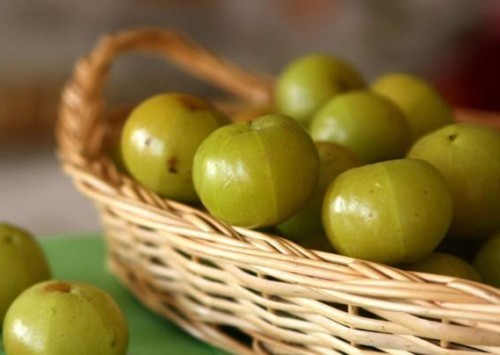India’s thali culture: platters for plates
As one travels across India, it can be particularly interesting to see how a veggie or a set of spices is cooked in styles so varied, the entire experience of tasting a dish changes. In the first and second part of this series of articles, we described thalis or platters from the western and eastern borders of the country. Here is a look at some region and culture specific food items.
Jharkhandi
Like many other cuisines from India, delicacies from Jharkhand too use rice dominantly. However, unlike some states like West Bengal, which are particularly known for their rice consumption, Jharkhand is known for its tribal food. Dhuska (deep fried rice flour pancakes served with gram curry and potato), dal pitha (lentil stuffed dumplings), baiganee chop (a snack made of sliced eggplant) and different kinds of rotis or breads prepared with rice. A traditional meal usually ends with thekua (a sweet dish made of sugar, wheat, flour, and chopped coconuts) and also hadia (a refreshing drink made of paddy rice).
Sindhi
Rooted in the Sindh province of Pakistan, which was part of undivided India, Sindhi cuisine is influenced by Mughals, Arabs, Turks and other dynasties that ruled over the Sindh. Most dishes in the cuisine are deep fried! A typical meal in most Sindhi households consist of phulka (wheat-based flatbread) and rice accompanied by two dishes- one with gravy and the other dry. Kamal kakri (lotus stem) is a popular ingredient. Sindhi kadi (yoghurt based dish), sai bhaji (green vegetables), koki (a popular breakfast item made of wheat flour) and besan bhaji (chickpea flour) are some popular dishes. The common ingredients used for any dish preparation is mango powder, tamarind, kokum flowers, and dried pomegranate seeds.
Kumauni
Kumaon region in Uttarakhand is known for its simple and nutritious food. Prepared to suit one’s lifestyle in the coldness of the Himalayas, it has the richness of local ingredients. Several snack items, breads, dairy products and beverages from the region are eaten across the state. A traditional thali include pulses such as gehet (a local bean) prepared in different styles like ras bhaat, faanda and thatwaani. Jholi or curry seasoned with curd is a delicacy enjoyed alongside rice. Chudkani and joula made from pulses and mandua (cereal) are also popular dishes. A chutney or sauce made from hemp seeds is also commonly consumed.
Malwani
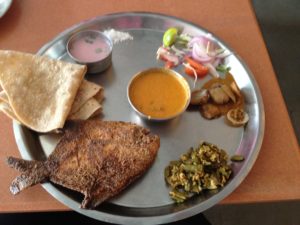
The use of a special Malwani masala (mix of spices) along with coconut and kokam gives the cuisine its identity
Malwani cuisine is a specialty of the tropical area which spans from the shore of Devgad Malwan to the southern Maharashtrian border that touches Goa. The use of a special Malwani masala (mix of spices) along with coconut and kokam gives the cuisine its identity. Various kinds of red and green fish, prawns, crab, and shellfish curries along with kombadi (chicken) and mutton are some popular dishes. Mohari mutton is also one of the specialities and is enjoyed the most with rice. A fish thali, is a unique offering of Malwani cuisine, with fishes like surmai, karali, bangada, bombil (Bombay duck), paplet (pompret), halwa, tarali, suandale, tisari (shell fish), kalwa (stone fish) making up the platter. There are also chutneys (sauces) prepared using fish. A festive Malwani thali includes different types of rice, breads and pancakes. One could pick from their tandlachi bhakari, ghawane, amboli, patole, appe, tandalachi and shavai .
Nagaland
Cuisine from Nagaland is known for its pork dishes cooked with some unique ingredients like the extremely hot bhut jolokia (one of the spiciest chillies in the world), fermented bamboo shoots and akhuni (fermented soya beans). Another unique and strong ingredient used by the Naga people is the fermented fish known as ngari. A lot of fresh herbs and other local greens are also a part of Naga cuisine. Oil is used sparingly; fermenting is preferred, meat and fish are dried smoked.
Article with inputs from Shailendra Bhandari , executive chef , The Metropolitan Hotel & Spa, New Delhi


